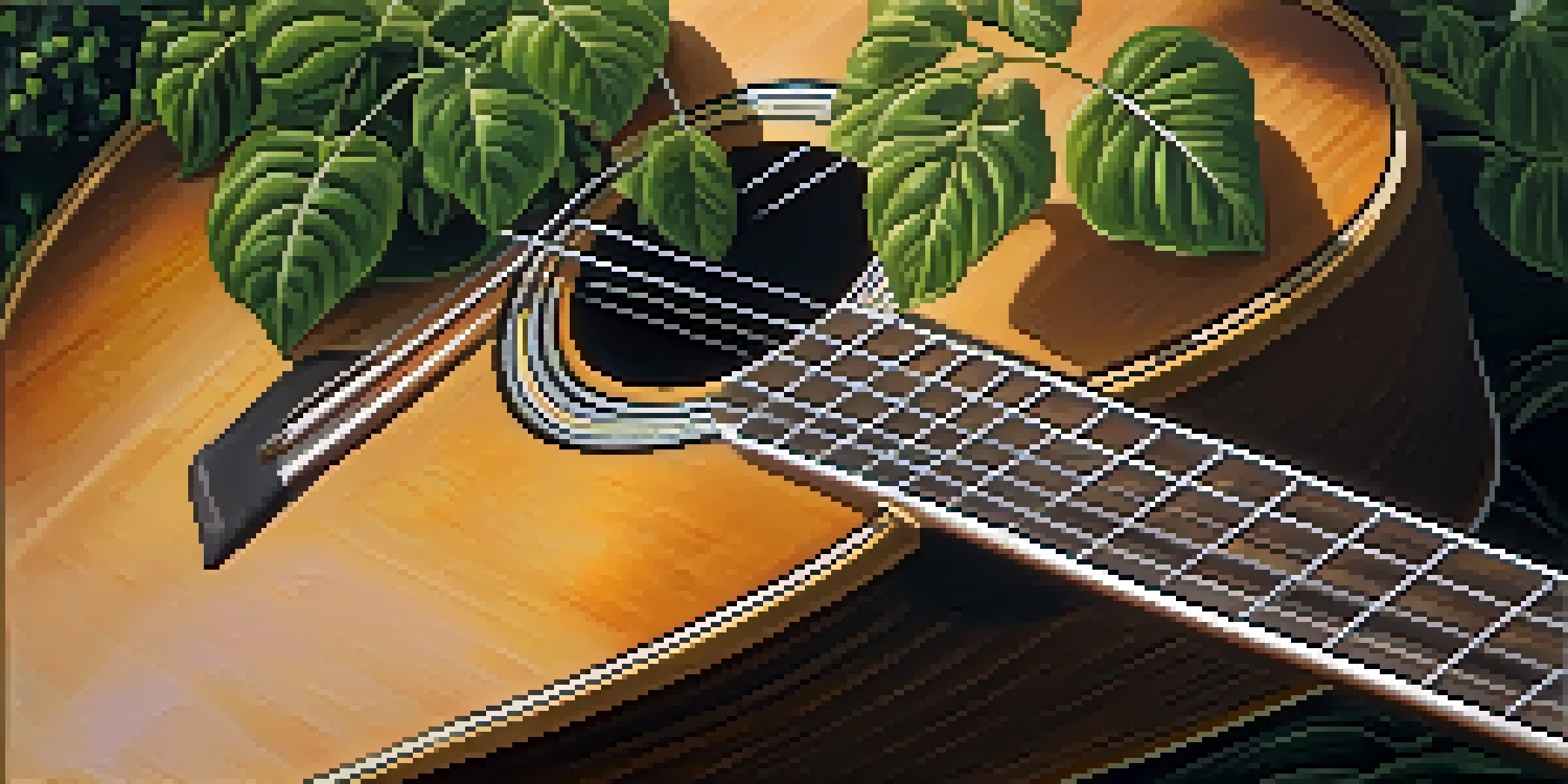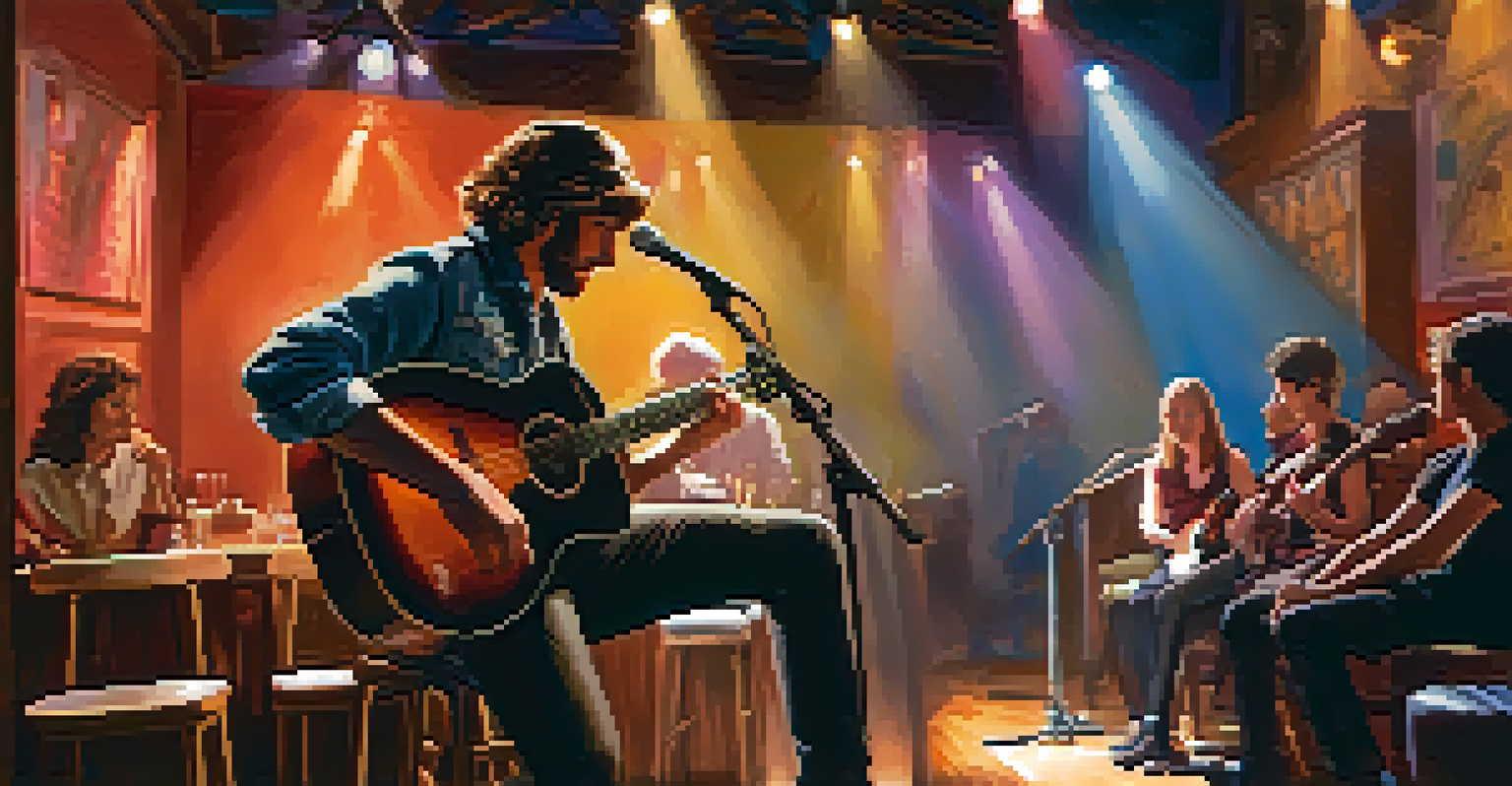Personal Stories Told Through Guitar Melodies and Chords

The Emotional Language of Guitar Music
Guitar melodies often serve as a universal language, transcending barriers and speaking directly to the heart. Each note can evoke feelings of joy, sadness, nostalgia, or hope, making it a powerful tool for storytelling. Just like a well-written novel, a simple chord progression can unfold a narrative that resonates deeply with listeners.
Music is the shorthand of emotion.
Consider how a soft, finger-picked melody might remind someone of a cherished memory, like a summer spent with loved ones. The way the sound flows can mimic the rise and fall of emotions, inviting listeners to reflect on their own experiences. This emotional connection is what makes guitar music so captivating; it allows artists to express their innermost thoughts and feelings.
In essence, the guitar becomes an extension of oneself, painting vivid pictures through sound. Each strum and pluck adds layers to the story, making it both personal and relatable. This unique aspect of guitar music is what draws people in and keeps them coming back for more.
Crafting Personal Narratives with Chords
Every musician has a story to tell, and chords are essential in shaping that narrative. By choosing specific chord progressions, artists can create moods that align with their experiences, whether it's the somber embrace of a minor key or the uplifting nature of a major scale. For example, a simple I-IV-V progression can evoke feelings of nostalgia and warmth, reminiscent of childhood memories.

As musicians experiment with different combinations of chords, they can convey complex emotions and stories. A transition from a soft, melodic section to a more powerful strumming pattern can signify a turning point in a narrative, mirroring the ups and downs of life. This dynamic interplay between chords and storytelling keeps listeners engaged and invested in the music.
Guitar Music as Emotional Language
Guitar melodies evoke deep feelings, allowing artists to share personal narratives that resonate with listeners.
Ultimately, the way chords are arranged can reflect the artist's journey, making the music feel authentic and relatable. Each performance becomes a unique moment where personal stories intertwine with melodies, creating a shared experience between the artist and the audience.
Melodies as Reflections of Life Experiences
Just like a diary, melodies can capture fleeting moments and emotions from our lives. When musicians compose, they often draw from their personal experiences, translating feelings of love, loss, or triumph into musical phrases. For instance, a rising melody may symbolize hope, while a descending line might express sorrow, perfectly encapsulating the highs and lows of human existence.
The guitar is a miniature orchestra in itself.
Listeners often find themselves relating to these melodies on a personal level, as the music resonates with their own experiences. A beautifully crafted melody can transport someone back to a pivotal moment in their life, making the music feel deeply intimate and personal. This connection is what makes live performances so powerful; people come together to share in the emotions conveyed through music.
Ultimately, melodies serve as a bridge between the artist's experiences and the audience's emotions. They create an unspoken understanding that enhances the impact of the story being told, allowing listeners to reflect on their own journeys.
The Role of Lyrics in Enhancing Guitar Stories
While melodies and chords are crucial, lyrics provide an additional layer of storytelling in guitar music. They allow artists to articulate their experiences more directly, painting a vivid picture of their thoughts and emotions. A poignant lyric paired with a simple guitar riff can create an unforgettable moment, where the listener feels seen and understood.
For example, songs that explore themes of heartbreak often combine raw, emotional lyrics with haunting guitar melodies, amplifying the feelings conveyed. This synergy between lyrics and guitar work creates a powerful narrative that resonates deeply with audiences. The combination of words and music makes the story more accessible, allowing listeners to engage with it on multiple levels.
Cultural Influences Shape Stories
Different musical genres infuse guitar storytelling with cultural narratives, enriching the emotional landscape of the music.
Moreover, well-crafted lyrics can serve as a guide through the emotional landscape of a song. They offer context and depth, helping listeners navigate the narrative while the guitar provides the atmosphere. This interplay enhances the overall experience, making the story told through the guitar even richer.
Cultural Influences on Guitar Storytelling
Guitar music is deeply influenced by cultural backgrounds, which shape the stories told through melodies and chords. Different genres, such as blues, folk, and flamenco, carry distinct narratives that reflect the experiences of their respective cultures. For instance, blues often tells tales of struggle and resilience, rooted in the African American experience.
As musicians draw from their cultural heritage, they create music that resonates with their identities and communities. This cultural storytelling enriches the musical landscape, introducing diverse perspectives and experiences. When listening to a guitar piece influenced by a specific culture, one can often feel the weight of history and emotion embedded within the music.
Furthermore, as guitarists explore these cultural influences, they also contribute to a broader understanding of shared human experiences. By merging different styles and stories, artists can create a tapestry of sound that celebrates diversity while highlighting our commonalities as individuals.
The Therapeutic Power of Guitar Music
Beyond storytelling, guitar music offers therapeutic benefits for both the musician and the listener. Playing guitar can serve as a form of self-expression, allowing individuals to process their emotions and experiences. Many find solace in writing songs, using music as a safe space to explore their feelings and share their stories.
Listeners, too, can find comfort in guitar music, as it often provides an emotional outlet during difficult times. A gentle melody can soothe a troubled mind, while an upbeat song can inspire motivation and joy. This healing aspect of music creates a powerful bond between the artist and the audience, where personal stories become a source of collective strength.
Therapeutic Benefits of Guitar
Playing and listening to guitar music offers emotional healing and mindfulness, fostering a connection between artist and audience.
Moreover, the act of playing guitar can foster mindfulness, pulling individuals into the present moment. As musicians focus on their playing, they may find themselves momentarily free from life's stresses, creating a therapeutic cycle of expression and reflection. This connection to the self and others through guitar music can be profoundly enriching.
Sharing Personal Stories Through Live Performances
Live performances are where personal stories truly come to life. The energy of a live audience can amplify the emotions behind the music, creating a shared experience that transcends individual narratives. When artists perform, they invite listeners into their world, letting them feel the weight of their stories through every note and lyric.
For many musicians, sharing their personal stories on stage is both a vulnerable and empowering experience. It allows them to connect with others who may have faced similar struggles or joys, fostering a sense of community. The emotional exchanges that occur during these performances often leave a lasting impact, creating memories that both the artist and audience carry with them.

Ultimately, live performances serve as a celebration of personal storytelling through guitar music. They remind us of the power of connection, as we come together to witness and share in the narratives that resonate with our own lives.